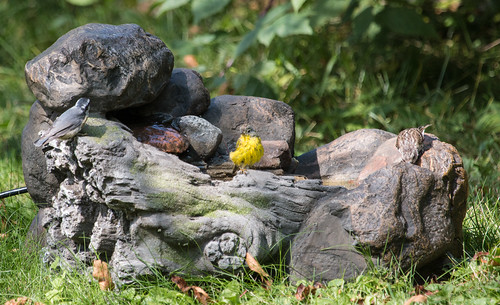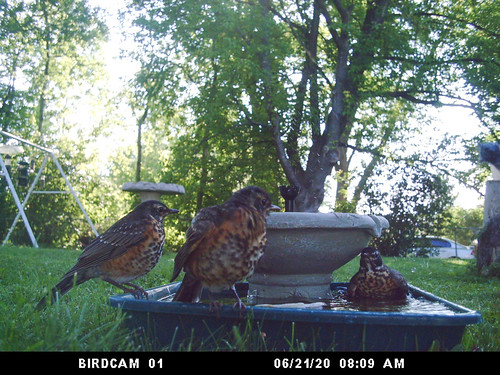Not since the 1980s, when my children were little, have I spent every single day of April, May, June, and July at home; August and September promise more of the same. And even back in the 80s, when I felt so housebound, we made frequent trips to visit Grandma and Grandpa in Port Wing, Wisconsin, and Russ adjusted his workday schedule to accommodate my going birding at local hotspots like Park Point and the Western Waterfront Trail.
Back then, while I was still trying to amass a big yard list, I paid very close attention to my backyard birds, but after my second year on Peabody Street, it was tricky to add new ones except during migration. It wasn’t that I lost interest in backyard birds in July and early August—there were so very many Evening Grosbeaks, and how could I ignore them? But now, thanks to the pandemic, I’m paying closer attention to even the most common birds in my backyard than I ever did before.
Tragically, my favorite birdbath, with an electric recirculating fountain, died this spring. Russ and I made a new birdbath out of an old plastic kitty litter box and a solar-powered recirculating fountain from an old, broken birdbath—lots of robins have been using that all summer, and now Blue Jays have discovered it, too.
Every August warblers always appeared at my old birdbath, and so to help make sure that still happens without my old bath, I bought two shallow 20” birdbath basins, one 10” stand, and a water mister/dripper. I have them set together so when the basin on the stand fills, any overflow drops into the lower basin. I have this set up right next to Russ’s raspberry patch not far from our crabapple tree, giving any visitors good places to duck out to if a hawk flies over.
I have no idea why, but this year we have had more rabbits on Peabody Street than ever before. At least four litters of bunnies were born in Russ’s raspberry patch, and I’ve taken more bunny and rabbit photos in the past several weeks than in the previous 68 years.
Lucky for me and those babies, no owls have been in our yard so far. But I’m getting lots of emails from listeners and blog readers asking about the owls in their neighborhoods, and especially about some screechy hisses they hear at night. Barn Owls are famous for their screechy hiss call, but they don’t breed up here, and even within their range, Barn Owls never nest in forested areas. What people are mainly hearing are begging baby Barred and Great Horned Owls. When those young leave their nests, they are almost full grown but can’t fly yet—they’re called “branchers” for their habit of hanging onto branches for dear life. Sometimes they do fall to the ground and sometimes may be stuck there for a day or two. If they can stay hidden, they’ll be just fine—their parents are perfectly capable of finding and feeding them. But dogs and cats can make short work of them—the owlets’ talons are sharp and strong, but they’re too inexperienced to know how to use them. They are still capable of inflicting damage on any people who try to help them.
The best advice if you come across an owl on the ground is to see if it appears injured, and if it is, call a rehabber for instructions. With binoculars, you might be able to tell if one of a Great Horned Owl’s eyes looks off—head injuries caused by falls sometime cause concussions or other head injuries that could make one pupil fixed and dilated. But owl parents do better than even the finest rehab facilities at not just keeping their young alive but educating them for life in the wild, so don’t interfere unless it really is necessary.
As August proceeds, we’ll see fewer and fewer dependent young birds, and migration will start kicking in. Unlike in the 1980s, I won’t have much of a chance of adding to my yard list, but I’ll be out there watching, and photographing. It’s the right way to fill my time during a pandemic. Stay safe and well, dear reader.



